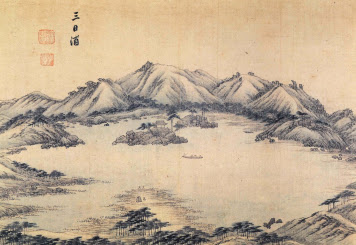I've been looking in this 1991 anthology for any interesting landscape-related poems that Peter H. Lee didn't include in The Columbia Anthology of Traditional Korean Poetry, a book I discussed here nineteen years ago. I soon found one - the first poem in the book is a 1580 kasa by Chŏng Ch'ŏl (1537-94) which Lee calls The Wanderings (1580). Its Korean title is Kwandong pyŏlgok* - sometimes rendered as the Song of Diamond Mountain or Song of the East Coast. Kwangdong is the name of the region that contains the spectacular Diamond Mountains (Geumgangsan), which I have discussed here before in relation to the artists they inspired. Chŏng Ch'ŏl's poem begins in Seoul where the king appoints him governor. He heads north and endures a sleepless night at Chorwon, a town which is now right on the North Korean border. After encountering magpies chattering on an old royal tomb (at least metaphorically), he sets off for the mountains, letting 'my staff lead me'. He walks through Hundred Rivers Canyon to Myriad Falls Grotto, and admires the falling water: 'there silver rainbows, / dragons with jade tails, / turning and coiling, spurt cataracts.'
In an ideal world someone would have written an illustrated guide to the Diamond Mountains, detailing all the most famous scenic spots, arranged alphabetically or geographically, and illustrating them with literary quotations, paintings and contemporary photographs. One reason my ideal library contains no such volume is that it would be a little hard to write this now, since many of the beauty spots are in North Korea. And, of course, while the mountains and sea might have been familiar to Chŏng Ch'ŏl, specific sites he visited have gone. Early in the poem he passes through Pyohunsa Temple which is still there, but it is the only one of the Diamond Mountains' four great temples that survived the Korean War - American bombers destroyed Singyesa, Jangansa and Changansa. Another temple, Naksansa, was devestated by fire in 2005, although most of its buildings only dated from the fifties, when it was rebuilt after having been reduced to rubble in the war. Chŏng Ch'ŏl visited Naksana, where he got up at dawn to watch the sun rise over the sea. Naksana is one of the Gwandong Palgyeong, eight scenic spots along the eastern coast of Korea which became famous in the sixteenth century.
Gim Hongdo, Lake Samilpo
from an album of late 18th century Landscapes Around Mt. Geumgangsan
Source: Google Art
Lake Samilpo is another famous landscape. It sounds lovely but is now inaccessible, north of the border. Chŏng Ch'ŏl visited and found six red letters on a cliff commemorating the four knights of Silla. 'After three days here / where did they go?' Legend has it that these four Hwarang stayed for three days and nights because they were captivated by the beautiful scenery (Samilpo means Three Days Cove). The Hwarang were Korea's elite male warriors, the 'flowering youth' schooled in Buddhism who visited mountains to train and try to receive supernatural guidance. They flourished as fighters between the mid-6th and mid-7th centuries, after which they became more of a social elite (they feature in later poems like the mid-8th century 'Ode to Knight Kipa': 'Knight, you are the towering pine / That scorns frost, ignores snow.') These four had been in the Diamond Mountains and were on their way down the coast to take part in a martial arts competition. Chŏng Ch'ŏl wonders where the four would have stayed next: 'Were they sitting at Clear Torrent Arbor / or on Myriad View Terrace?'
Peter H. Lee discusses Chŏng Ch'ŏl's poem in his History of Korean Literature. He says 'the reader feasts on a continuous unfolding
of scenes described from various perspectives, encompassing both the sky
and sea, and engaging all the senses ... Chŏng’s bold descriptions show great skill in conveying a magnificent scene of nature in simple but carefully chosen words.' I will end here with the poet's description of Mirror Cove, which is northeast of Gangnung and was another of the Eight Scenes of Gwandong.
Behind the old pines rimming like hedgesI scan a ten-mile long beachlike ironed and stretched white silk;the water is calm and clear,I can count the grains of sand.


